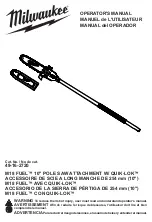
14
EN
•
lung cancer
•
Silicosis
•
Chronic obstructive pulmonary disease (COPD).
The risk of lung disease is linked to people who regularly breathe construction dust
over a period of time, not on the odd occasion.
To protect the lung, the COSHH Regulations sets a limit on the amount of these dusts
that you can breathe (called a Workplace Exposure Limit or WEL) when averaged over
a normal working day. These limits are not a large amount of dust: when compared to
a penny it is tiny – like a small pinch of salt:
This limit is the legal maximum; the most you can breathe after the right controls have
been used.
How to reduce the amount of dust?
1. Reduce the amount of cutting by using the best sizes of building products.
2. Use a less powerful tool e.g. a block cutter instead of angle grinder.
3. Using a different method of work altogether – e.g. using a nail gun to direct fasten
Please always work with approved safety equipment, such as those dust masks that
at all time.
For more information please see the HSE website:
http://www.hse.gov.uk/construction or http://www.hse.gov.uk/pubns/cis69.pdf
WARNING! Some dust particles created by power sanding, sawing,
grinding, drill and other construction jobs contain chemicals known
to cause cancer, birth defects or other reproductive harm.
Some
examples of these chemicals are:
•
Lead from lead-based paints.
•
Crystalline silica from bricks and cement and other masonry products.
•
Arsenic and chromium from chemically treated timber.
Your risk from these exposures varies, depending upon how often you do
this type of work. To reduce your exposure to these dusts:
•
Work in a well-ventilated.
•
Work with approved protective equipment, such as those dust masks
NOISE
SEE TECHNICAL SPECIFICATIONS IN THE INSTRUCTION MANUAL FOR THE
NOISE LEVELS OF YOUR TOOL.
The declared noise emission value(s) has been measured in accordance with
EN 62841-1 and EN 62841-3-9 and may be used for comparing one tool with another.
The declared noise emission value(s) may also be used in a preliminary assessment
of exposure.















































